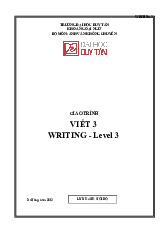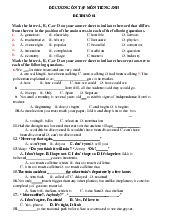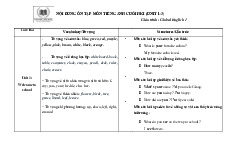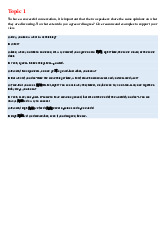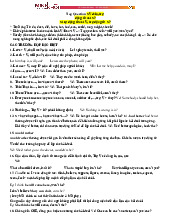







Preview text:
lOMoAR cPSD| 47708777
II. Most of the policies used in Vietnam
1. Direct government intervention
1.1 Price ceiling (or maximum price – Pmax ) -
The ceiling price is the highest price that investors can sell or buy, appearing in many
different fields such as securities or economic sectors. Once this price has been set, the participants are forced to comply. -
When an organization or agency or government has imposed this price, it means that they
are intending to protect consumers, who are considered to be weak in a transaction or competition in the market. -
For example, when the Vietnamese team plays at My Dinh Stadium, ticket issuers have the
right to impose different prices. However, the highest price that can be sold is 1,500,000
VND/ticket in the most beautiful location possible. This is called the price ceiling. -
Or suppose, in the stock market, the ceiling price of the day investors can sell is 500,000
VND/share and must not exceed this level. With this condition, those who are in need and
economically weaker can still buy the stocks they need. -
This adjustment and imposition of a price ceiling is said to be one of the policies to ensure
and balance the interests of the parties. It really makes social sense, providing better security for people with low net income. -
In fact, the regulation of the ceiling price also has great significance in controlling and
adjusting the supply and demand of the market. With some rare items, supply decreases and
demand increases or demand decreases supply increases. The state can use different top and
bottom price policies to create equilibrium in the market. -
When the government sets a ceiling price, there can be two cases: The ceiling price is lower
than the equilibrium price and the ceiling price is higher than the equilibrium price. •
When the ceiling price is lower than the equilibrium price (Pmax < Po): The ceiling price
regulation takes effect (graph 2.15a) •
If the ceiling price is higher than the equilibrium price (Pmax > Po): the ceiling price
regulation does not take effect, the market price remains unchanged, still P0, shown on the graph 2.15b.
Graph 2.15a depicts the effects of a price ceiling or maximum price policy, where P0 and Q0 are
the equilibrium points in the free market. If the government stipulates that the price cannot be lOMoAR cPSD| 47708777
higher than the allowable ceiling of Pmax (lower than the equilibrium price P0), producers cannot
supply as much as before, the quantity supplied is reduced, and vice versa, buyers buy back. want
to buy a larger quantity is Q2. As a result, the quantity demanded exceeds the quantity supplied,
and the market lacks a quantity of goods (Q2 – Q1). Scarcity is sometimes expressed in the form
of queues or quantitative forms, stamps.
Some people benefit and some lose from this intervention. Producers suffer, receive lower prices
than before and some have to stop production. Some consumers benefit because they can buy
goods at low prices, others who cannot buy goods will be disadvantaged because they have to buy
goods in an illegal market - the black market - at a price P0 higher than the normal price. P0 in free market conditions.
If the ceiling price is higher than the equilibrium price (Pmax > Po): the ceiling price regulation
does not take effect, the market price does not change, still P0, shown on the graph 2.15b.
1.2 Floor price (or minimum price – Pmin )
- The floor price is the lowest price at which a buyer can execute an order to buy or sell a certain type of transaction.
When the government sets a price floor, two cases can happen: The floor price is higher than the
equilibrium price, and the floor price is lower than the equilibrium price. •
When the floor price is higher than the equilibrium price (Pmin > Po): The floor price
regulation takes effect (graph 2.16a) •
If the floor price is lower than the equilibrium price (Pmin < P0): the floor price
regulation does not take effect, the market price does not change, still P0, shown on graph 2.16b.
- On graph 2.16a, P0 and Q0 are the equilibrium points in the free market, if the government
dictates that the price cannot fall below the allowable floor price Pmin At a high price Pmin,
the quantity supplied of Q1 is more than before. and conversely, buyers only want to buy a
smaller quantity than Q2. As a result, the quantity supplied exceeds the quantity demanded,
and the market has a surplus of goods (Q1 – Q2). It is clear that consumers suffer from this
intervention, since they have to buy goods at a price Pmin higher than the price P0 under free
market conditions. Producers receive a higher price than before, but reduce the quantity sold
from Q0 to Q2, if the government does not take measures to support by buying up excess
output, they will not have income to cover costs. production cost (Q1 – Q2). Examples for
floor price policy are minimum rice price, minimum wage. lOMoAR cPSD| 47708777
- Example: Countries often set floor prices for agricultural products to protect farmers. In
Vietnam, the government has set a floor price for rice. Can be illustrated on graph 2.16a. When
the government has not intervened, the equilibrium price of rice is at P0 and the equilibrium
quantity of rice is Q0. When the floor price Pmin is set higher than the equilibrium price, the
quantity demanded decreases while Q2, the quantity supplied increases to Q1. As a result, the
quantity supplied is greater than the quantity demanded, causing an excess of rice called AB. The
government has bought all the excess rice AB as national food reserve. In this case the farmer
benefits a lot, because sold at a higher regulated price and sold in a larger quantity than before the
floor price, and buyers were more disadvantaged than before.
In addition, the floor price is also reflected in the minimum wage policy of countries, in order to
help workers get better. The explanation is similar to the floor price of rice on chart 2.16a. When
the government sets a minimum wage higher than the equilibrium wage, the supply of labor will
be greater than the quantity demanded of labor, causing a situation of surplus or unemployment that is AB without work.
- If the floor price is lower than the equilibrium price (Pmin < P0): the floor price regulation has
no effect, the market price remains unchanged, still P0, shown on the graph 2.16b. 2. Indirect Invention 2.1 . Tax -
A tax is a compulsory financial charge, or some other type of levy imposed on a taxpayer
like an individual or legal entity. -
In practice, governments sometimes view levying a tax on a unit of a good as a form of
income redistribution or restricting the production or consumption of a certain good or service.
Through the supply and demand curves we can examine the effect of a tax. 2.1.1 . Impact of a tax
Supply is less elastic than Demand Producers pay more tax. lOMoAR cPSD| 47708777
Demand is less elastic than Supply consumers pay more tax.
Taxes increase the prices of goods and services for consumers or reduce income for producers.
• Competitive market: tax money is shared between producers and consumers.
• Perfectly competitive market: the tax is borne by the producer.
Taxes do not dramatically increase the prices of goods and services in the market.
Whether the buyer or seller is ultimately subject to that tax depends on the relative elasticity of supply and demand.
2.1.2 . Who bears more from a government tax?
a) If Demand is perfectly price elastic:
When demand is perfectly price elastic, taxes do not affect the market price, so the quantity
demanded decreases from Q1 to Q2, the market equilibrium shifts from E1 to E2 and the supply
curve shifts to the left. And the producer must bear the tax. b) If Demand is perfectly price inelastic: lOMoAR cPSD| 47708777
In this case, the tax raises the market price from P1 to P2 but the quantity demanded remains
constant Q1, the market equilibrium rises from E1 to E2, and the taxable is the consumer. c)
If Supply is perfectly price inelastic:
In this case, when the quantity supplied remains the same at all prices including the addition of a
tax on the good, the market price increases from P1 to P’ and the quantity supplied decreases
from Q1 to Q’, the taxpayer is the producer.
2.1.5 . Tax example exercise
Assume that the demand and supply functions for good X are as follows: QD = - 2P+206 QS = 3P – 69
( The unit of price is thousand dong/kg, the unit of quantity is thousand tons ) Request:
a) Determine the equilibrium quantity and price and total revenue of producer? lOMoAR cPSD| 47708777
b) Assuming the government levies a tax of 20,000 VND/kg, determine the equilibrium quantity,
the price consumers pay (PD) and the price producers receive (PS).
c) How much tax does the government collect? Who pays more tax, specifically by how much? 2.2 . Subsidize
A government subsidize is a form of financial support or assistance extended to an economic
sector for the purpose of promoting economic and social policy.
Subsidies can be viewed as a negative tax. Thus, in contrast to taxation, the government views
the subsidy of a certain amount per unit of a good as a form of support for production or consumption.
Like analyzing the impact of a tax, we can examine the impact of a subsidy through the supply
and demand curves. 2.2.1 . Impact of a subsidies
The government subsidies s of dong per unit of a good to producers in order to be able to supply
a higher output than before at any market price the supply curve will shift to the right or down
by an amount equal to the subsidies s.
2.2.2 . Who benefits more from government subsidies?
a) Demand is perfectly price-elastic:
When demand is perfectly price elastic, government subsidies do not affect market prices, the
equilibrium shifts from E1 to E2, quantity demanded increases from Q1 to Q2, subsidies go to producers.
b) Demand is completely price inelastic: lOMoAR cPSD| 47708777
When the market price falls by exactly the level of the subsidy, the quantity demanded remains
the same, the equilibrium moves from E1 to E2, and the from price P1 falls by an amount equal to
the subsidy to P2, and the consumer is the beneficiary. c) Supply is completely price inelastic:
In this case, Supply is completely price inelastic, the producer enjoys the full subsidies, and the market price stays the same.
Thus, ultimately, whether buyers or sellers benefit from government subsidies depends on the
relative elasticity of supply and demand. In general, producers will receive most of the subsidy if
demand is much more elastic than supply.
2.2.3 . Subsidies example exercises :
Exercise 1: Fill in the blanks: When the government subsidizes an activity, resources such as
labor, machines, and bank lending will tend to gravitate __________ the activity that is
subsidized and will tend to gravitate ___________ activity that is not subsidized. a. toward;
away from ( correct answer ) b. toward; toward c. away from; toward lOMoAR cPSD| 47708777 d. away from; away from
Exercise 2: Some people with diabetes absolutely need to take insulin on a regular basis to
survive. Pharmaceutical companies that make insulin could find a lot of other ways to make
some money. If the U.S. government imposes a tax on insulin producers of $10 per cubic
centimeter of insulin, payable every month to the U.S. Treasury, who will bear most of the
burden of the tax? * a. Insulin producers
b. People with diabetes ( correct answer )
c. Not enough information is given
